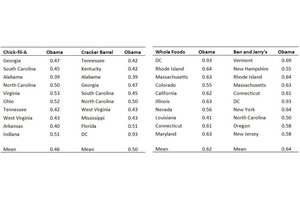Food fight! Can food brands predict elections?
People living near a Cracker Barrel are less likely to vote for Obama than those who live near Whole Foods. The food factor is even stronger if you compare voting preference and search traffic for Chic-fil-A and Starbucks.

X
Rule 22
A few weeks ago on Meet the Press, Chuck Todd proposed that the fate of the Senate could come down to the distribution of Starbucks coffee shops (an elitist, urban chain) vs. Chick-fil-A restaurants (propagated by rural, social conservatives). He predicted “it could be advantage to the chicken” this November. Click here for a video of Todd’s segment.
David Wasserman of FiveThirtyEight went one step further, taking the time to actually map Chick-fil-A and Starbucks locations. Because, you know, data! He then compared the distribution of both restaurants and compared them with Obama’s vote share in 2008. Here’s what Wasserman found:
When I mapped Chick-fil-A’s 1,845 stores, what I found surprised me: A majority (52 percent) are located in counties President Obama won in 2008 and 49 percent are in counties he carried in 2012. On the flip side, it might surprise Todd’s viewers that 57 percent of the 976 American counties with a Starbucks voted for John McCain in 2008 and 63 percent voted for Romney in 2012.
Wasserman proceeds to remind voters of an earlier post of his (see here) showing that, unlike Chick-fil-A and Starbucks locations, the number of of Whole Foods stores and Cracker Barrel restaurants does correlate highly with Obama’s vote share. He notes:
In 2012, Obama won 77 percent of all counties with a Whole Foods and just 29 percent of all counties with a Cracker Barrel.
Now, yes, food can be political. Look no further than pizza, where we can easily find not one, but two examples of this. BrandIndex (a company that tracks the reputations of food chains) reports that perceptions of Godfater’s Pizza soared with Republicans and dropped with Democrats after their former CEO – the one and only Herman Cain – decided to run for president. We saw the same pattern with pizza chain Papa John’s, after it’s CEO, John Schnatter, promised to reduce workers hours and increase pizza prices after Obama’s 2012 victory.
But while food can be political, I’m not satisfied with either Chuck Todd or David Wasserman’s dichotomy. Let’s have a food fight!
What follows is a summary of a 2011 post of mine on this very issue. In that post, I proposed a better way to correlate peoples’ culinary habits with their voting behavior. Rather than examine the volume of restaurants in a geographic area, let’s look at Google search traffic for these eateries.
I see three advantages with this approach. First, it’s easy! Just play with Google Trends for a few minutes and you’ll see why. Second, the number of restaurants in a geographic area is pretty far removed from the unit of analysis (people). In contrast, voting behavior and search traffic both derive from individual level behaviors. And third, the geographic location of a restaurant (Cracker Barrel) vs. a large grocery store (Whole Foods) has more to do with geographic dispersion and population density than anything else. It’s not surprising that Cracker Barrels are more numerous in less populated, rural settings: They cost less to build and operate! In contrast, you wouldn’t put a 35,000-sq.-ft. Whole Foods in a small town (irrespective of whether people in that town are staunch social conservatives or big government lefties).
In this old post, I proposed two more reliably partisan food chains: Chick-fil-A (like Chuck Todd) and Ben and Jerry’s? Chick-fil-A, after all, gave Tea Party protestors free iced tea on April 15, has donated nearly $2 million to anti-gay rights groups, and is closed on Sundays so their employees can “rest, spend time with family and friends, and worship if they choose to do so.” Ben and Jerry, by contrast, are two self-described “liberal lefties” who fed ice cream to 600 Occupy Wall Street protestors and adopt (gasp) fair trade practices. In short, these two chains exhibit clear ideological differences (rather than simply correlate with it).
In order to examine this issue and pit the two typologies against each other on a comparable scale, I coded Google Trends data for the states with the top 10 search results for each of the four chains. I then merged that with Obama’s share of the two-party vote. Here are the results.
It appears that my typology with Chick-fil-A vs. Ben and Jerry’s stacks up favorably – if not better – than the Cracker Barrel vs. Whole Foods divide. By my count, Obama received 64% of the two-party vote in Top 10 states for Ben and Jerry’s searches and only 62% in the Top 10 states for Whole Foods searches. Clearly this difference isn’t statistically significant, but it’s a marginal improvement. In contrast, Obama only received 46% of the two-party vote in top 10 states for Chick-fil-A searches and 50% in top 10 states for Cracker Barrel searches.
Of course, there are perfectly good explanations for these effects. And to his credit, in his old post Wasserman notes one study, Bill Bishop’s “The Big Sort," which argues that Americans are geographically sorting into homogeneous clusters (and the factors which drive this clustering correlate with political ideology).
Jordan Ragusa publishes his Rule 22 blog at http://rule22.wordpress.com/.

